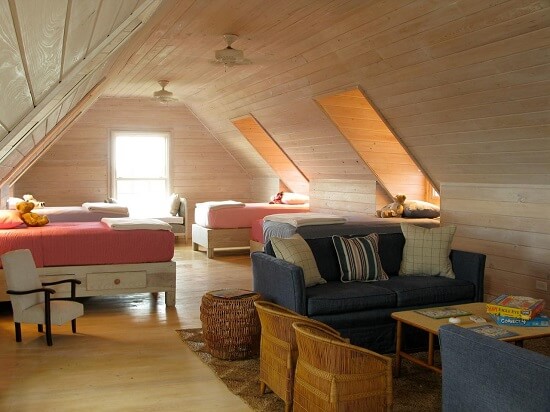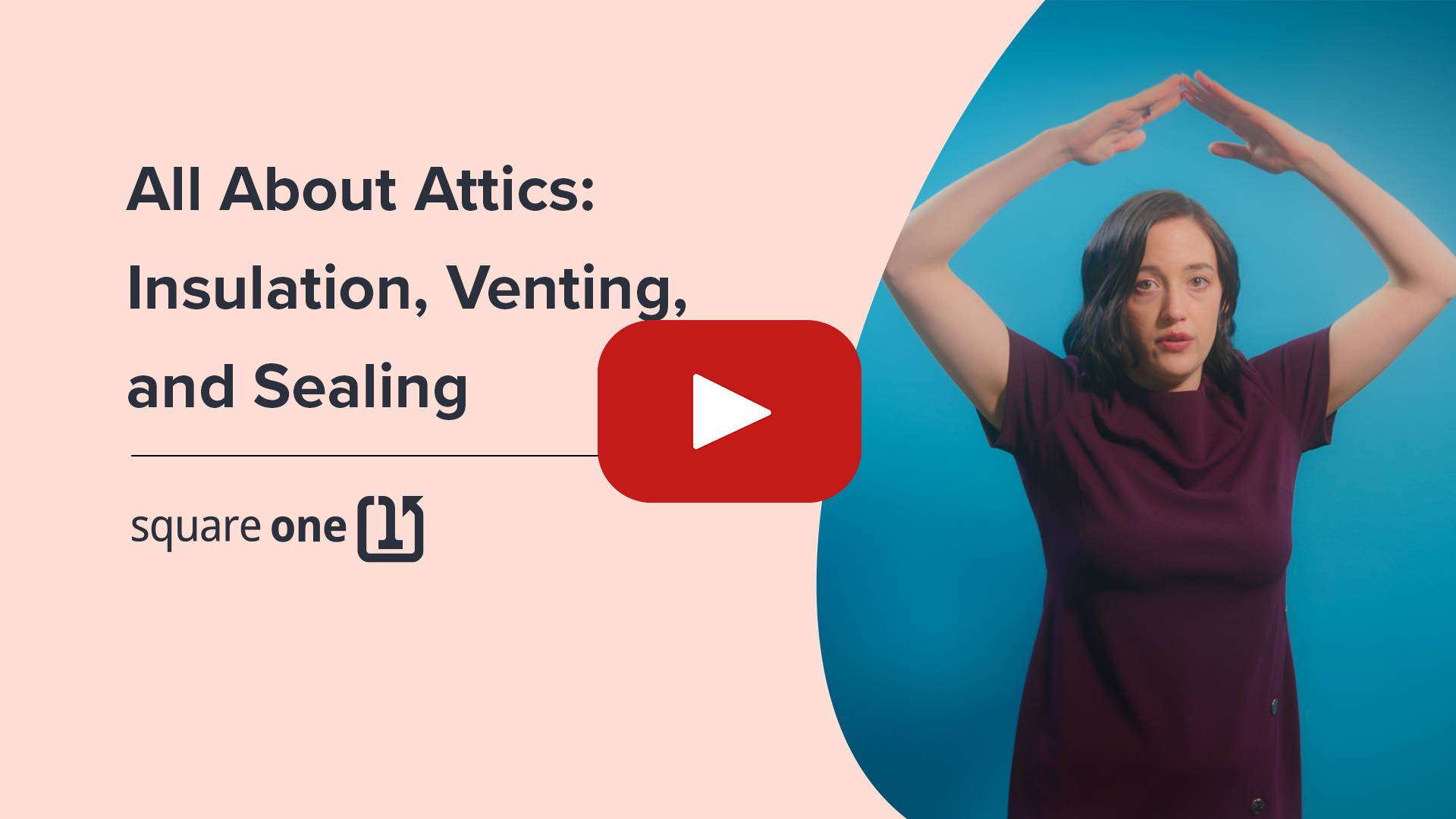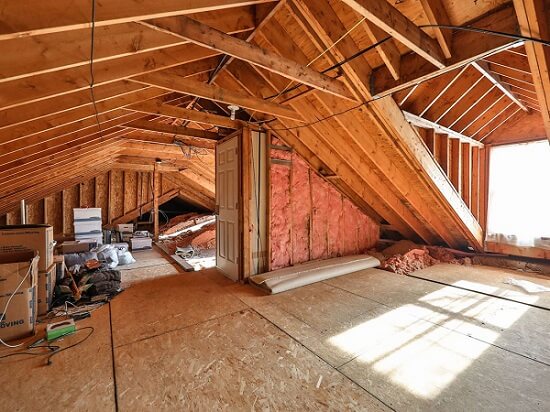Converting your attic to living space

What if you do need more living space?
It may be difficult, or impossible, to build an addition onto your home. If that’s the case, why not look up instead of out?
Converting an attic into a den, extra bedroom or even a home office is common, but there are many things to consider before going ahead:
Increased load
Most attic floors are designed to hold a layer of lightweight insulation, not a bedroom furniture set. You should call a building inspector to figure out if your attic is strong enough to hold the extra weight of furniture, flooring, and people.
There may be some structural limitations in your attic that make renovating impossible or at least prohibitively expensive.
A lack of head room, for example, may require you to raise the roof or lower the ceiling of the room below, both pricey options. A lovely attic space won’t seem so lovely if you have to walk around bent over. What’s more, some building codes stipulate minimum headroom requirements. If your attic doesn’t meet those requirements, you won’t be able to secure the building permits you need for the renovation.
If you’re lucky, you’ll need only add some extra floor joists for support. The floor of the attic forms part of the ceiling for the main living area below. If the floor can’t handle the additional weight, you could end up with sagging ceilings, damaging the structural integrity of your entire home. As a bonus, extra floor joists (along with carpets) help muffle noise coming from the attic into the rest of the home.
Accessibility
Take a look at your attic access. Have you got the room for a proper staircase?
You might be able to fit a space-saving spiral staircase, but what about moving furniture in there? Will you have enough room to maneuver, or are you going to be hoisting the mattress up through a window? Does your attic even have windows? You’ll probably need those too, both for natural light and as a potential fire escape route.
You’re also going to need to deal with building code requirements with regard to the type of staircase you can put in, and the size of the landing, not to mention the aforementioned ceiling height—you’ll probably need at least 7 feet.
Roof support
Whatever you do to your attic, you need to make sure the roof remains supported.
If you have W-shaped trusses holding up the roof, you may not be able to convert the attic to a living space. The trusses would have to be replaced with some other form of support, which is a massive project (and not a DIY candidate). These significant renovations can push the cost well beyond what’s realistic for your project.
Other attics have A-shaped trusses, which offer more headspace. These may make converting your attic a much simpler (and cheaper) option.
A building inspector can evaluate your space, and let you know whether it complies with the building code requirements.
Insulation
Once again, we come to insulation.
You may have had great insulation between your main house and your attic, but now you need to insulate the attic ceiling, too.
Here, spray foam insulation comes highly recommended. It’s more expensive than it’s fluffy fibreglass counterpart, but it’s also effective.
Without the right insulation, you’re either going to roast or freeze up in your new living space.
Liveability
If you’ve ticked all the other boxes, all that’s left is to think how you’ll make your attic livable.
A ceiling fan helps keep the attic warmer in winter and cooler in summer. Storage space is another consideration. Even if the new space is a bedroom or den, you can still build in some storage room. Try to use every bit of available space: install built-in shelves in low walls, or in the corners.
Wouldn’t it be nice to have a bathroom in the space so there’s no need to run up and down stairs? Of course, this adds to the cost, but if you align your attic bathroom on top of an existing bathroom, you won’t need as much new plumbing.
If you’re renting out your newly renovated attic, make sure tenant insurance is required.
What will your home insurance provider want to know?
Your home insurance company may or may not ask about your attic directly. If they do, they might ask if it’s been converted into a living space. They might also ask if any of your home systems (like HVAC) run through your attic.
Even if your home insurer doesn’t ask about the attic, they’ll certainly want to know about your roof. Roofs are common sources of home insurance claims, including damage from leaks and ice dams. Accordingly, home insurance companies prefer to insure homes with well-maintained roofs.
Depending on the type of roof, if it shows signs of excessive wear, it may also be hiding an attic that’s suffering hidden water damage. Once moisture takes hold inside an attic, it can cause all sorts of problems that become awfully expensive to repair. If your roof looks like it needs some work, you may have a harder time finding home insurance (or at the very least, you’ll have to pay more for it).
Roofs and attics are closely related; an attic that’s sealed, insulated, and ventilated will help reduce the chances of your home suffering damage from water, mould, ice, and lots more.
Commonly asked questions
How long does attic insulation last?
Fibreglass insulation is the most common in Canada. Under perfect conditions, fibreglass insulation can last nearly as long as the building in which it’s installed—up to 100 years.
Of course, conditions are never perfect.
Moisture, compression, and the quality of installation all factor into attic insulation’s real lifespan. Hence, your attic’s insulation may only end up lasting 10 or 20 years.
Replacing insulation isn’t terribly expensive, so it’s worth replacing if it starts to degrade. If you’re not sure how well your insulation is faring, have a qualified inspector come and check it out.
How to insulate an attic?
Installing new insulation in your attic isn’t necessarily hard. The important things are doing it safely and doing it well. Poorly installed insulation won’t hold the heat as well as the R-value on the package says it will.
Prep your attic. First, get access to your attic. If yours doesn’t have an actual entryway, you look for a panel hidden away on the ceiling of a closet. You’ll likely need a ladder to get up there.
Once you’re up, prep your work lighting by hanging some portable work lamps.
If the attic has no floor, lay down some plywood boards to create walkways over the floor joists. It’s important to never step between the joists; that part of the floor isn’t meant to bear weight.
Find your insulation material. Fibreglass batts are the most common form of insulation in Canadian homes, and they’re plenty effective.
There are other materials, too including cellulose, foam, and even denim insulation. You can choose your attic’s insulation based on cost, and an R-value appropriate for the climate. R-50 insulation is adequate for attics in most parts of Canada, but you might opt for R-60 in the coldest regions.
There is also spray foam insulation, which is highly effective—when it’s installed properly.
If you want spray foam insulation, you should hire professionals to install it. There are more nuances to the process, and many building codes require it.
Start installing. Once you’ve got your materials, you’re ready to start. Make sure you’re wearing all the right protective gear, including eyewear, heavy gloves, and a dust mask. Fibreglass insulation throws tiny particles into the air, which can seriously irritate your lungs if you breathe them in.
Lay the insulation batts between the joists, making sure to cut them to size. Don’t squash them into place! Compressed insulation isn’t as effective. Make sure there are no gaps left uninsulated; even a tiny gap reduces the effectiveness of your attic’s insulation.
How much does it cost to build an attic?
The cost to convert your attic into a livable space varies a lot. If your attic isn’t already somewhat finished, you should expect to pay at least $5,000, and more likely a five-figure price tag.
Most often, the process of renovating an attic is not like renovating a kitchen or bathroom. Building a livable attic often requires extensive structural work. After all, you’re adding living space to the house in places that weren’t designed to accommodate it.
To start with, you’ll need to hire an architect to do a structural analysis, and possibly design a new support system for the roof.
Then, you’ll need to pay for the construction of that support system.
Then, you’ll need to actually install the flooring, walls, furniture, and so forth, including meeting all the building codes in your area for fire escapes, ventilation, head room… the list goes on.
On the other hand, if you just want to use your attic for storage, the price is much lower. It’s often as simple as installing plywood sheets over the joists to create a platform on which to store your stuff. Just be sure that you’re not overloading your joists or compressing your insulation.
How often should you check your attic?
Ideally, you should have a look in your attic at least once a year, and more frequently if the attic is easy to access. There’s no downside in checking often, and you might catch potential problems early enough to deal with them before they cause real headaches.
When you’re checking your attic, look carefully for signs of moisture and signs of rodents; these are the most common issues you’ll find in your attic.
How to get rid of rodents in your attic?
Speaking of rodents, attics are a prime habitat for them.
These are common signs that you have rodents living in your attic:
- Droppings
- Gnaw marks
- Urine-like smells
- Nests
- Scampering sounds in the ceiling
If you see any of these signs, take action right away. Particularly with mice, a single mouse can become dozens of mice before you know it.
Here’s what to do if you’ve got rodents in your attic:
- Figure out what kind of rodents they are. Mice are the most common, but rats like attics too. The easiest way to tell (other than seeing the actual rodents) is by the size of the droppings. Tiny dark pellets mean mice, larger ones mean rats.
- See if you can find where they got into the house and the attic. Check for gaps around vents, doors, windows, and anywhere a pipe or wire enters the building. Remember, mice can squeeze into impossibly tiny gaps.
- Make sure you have no food sources anywhere in your home. Seal all the food in your pantry and cupboards securely.
- Set traps, and lots of ’em. Whether you use typical snap traps or live traps is up to you, but make sure you buy the right kind of trap for your rodents; a mouse trap won’t do anything to a rat except make it angry.
Set your traps in areas that you suspect have the highest rodent traffic, based on the signs you found.
Check your traps daily. If any have tripped, reset them. Clean out any traps that caught a rodent and reset those as well.
- If your traps aren’t catching anything, or they’re catching many things and it’s not solving the problem, you might need to hire pest control professional.
Want to learn more? Visit our Getting to Know Your Home resource centre for the complete rundown on all your home's systems and features. Or, get an online quote in under 5 minutes and find out how affordable personalized home insurance can be.




